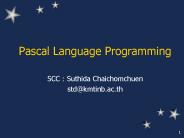Language (and Decomposition) - PowerPoint PPT Presentation
Title:
Language (and Decomposition)
Description:
linguistics productivity: new sentences, new words ... 'Irregularity' within language is governed by principles of structural locality ... – PowerPoint PPT presentation
Number of Views:31
Avg rating:3.0/5.0
Title: Language (and Decomposition)
1
Language (and Decomposition)
2
Linguistics provides
- a highly articulated computational (generative)
theory of the mental representations of language
that are used to account for - judgments of meaning and well-formedness
- linguistics productivity new sentences, new
words - language acquisition the ability of children to
project beyond their linguistic experience
3
Analysis of Invariance vs Analysis of Variance
- Linguist in a sentence like, John saw Mary,
the subject is the one who sees and the object
the one seen. - Psychologist In a picture-matching task,
position of the name in a sentence, initial vs.
final, was significantly correlated with behavior - i.e, explicitly contrast John saw Mary and
Mary saw John and do an experiment
4
Slides from Bobs Analogy lectureAnother
Example
John loves Mary
Mary loves John
5
Yet Another Example
John loves Mary and Bill hates Sally.
John loves Mary and Bill hates Sally.
Without Role Bindings
With Role Bindings
And
Conjunct 1
Conjunct 2
Loves
Hates
Lover
Beloved
Hater
Hated
Relational structure has been lost!
John
Mary
Bill
Sally
6
More Problems Representing Structure
- But role bindings alone dont solve the problem
of multiple instances of a predicate. - Example
- John bought the apples yesterday and the pears
last week. - John bought the pears yesterday and the apples
last week.
7
(No Transcript)
8
Representing Recursive Propositions in LTM
- A system with role bindings and instances of a
predicate can represent recursively embedded
propositions easily
9
Recursive Embedding Example 1
Sam knows Mary loves John
Knows
Knower
Known
Sam
10
Recursive Embedding Example 2
Mary kissing John caused John to hug Mary.
Cause
Cause
Effect
11
Structured RepresentationsA Linguistic Example
- What does rebuild mean?
- (1) After the hurricane, John rebuilt his house.
- Did John build the house to begin with?
- Does(1) presuppose that anyone built the house
before it was destroyed? - I'm going to pass on the help with the donation
to help rebuild the Old Man of the Mountain.
12
The Old Man of the Mountain
13
Representation of rebuild
- Involves a number of parts
- Building activity
- A caused creation as the result of building
- The presupposition end state of building
existed before - The linguist assumes that the complex structural
representation of these parts would underlie any
use or comprehension of the word
14
Tension The Status of Linguistic Representations
- In linguistics, a syntactic representation
mediates between sound (or letters, the hand
movements of sign, etc.) and meaning (interface
with other cognitive functions) - The linguist operates under the assumption that
language comprehension and production (as well as
the generation of judgments of well-formedness)
requires in every instance the creation of
syntactic representations
15
- The tradition in cognitive psychology is to
suppose that the linguistic representations are
abstract and either not necessarily or rarely
constructed when people speak and understand
language on a daily basis -- people can use
strategies, statistics, analogy, etc. to map
directly between sound and meaning.
16
Example Morphological Decomposition
- amiability
- Linguistic representation
- n
- adj
- root adj n
- ami able ity
- able predicts category, meaning and
potentiation of -ity
17
Pinker in Words and Rules3 Theories of
Irregular Morphology
- full decomposition
- gave GIVE PST gt give ø
- dual route (Pinkers mediation between linguists
and psychologists) - gave the past tense of give
- walked WALK PST gt walk ed
- single route
- gave the past tense of give
- walked the past tense of walk
18
From the linguists perspective, only the full
decomposition model makes any sense
- gave behaves as a complex form with respect to
syntactic and morphological distribution - the walkeding the gav(e)ing
- He walked/He didnt walk/He didnt walked
- He gave/He didnt give/He didnt gaved
19
Evidence for Dual Route View
- Lack of surface frequency effects for regular
inflection - RT to walked correlates with stem frequency of
walk rather than surface frequency of walked - While RT to taught correlates with surface
frequency of taught rather than stem frequency
of teach
20
- Lack of priming for irregulars
- walked primes walk but
- taught doesnt prime teach
- (darkly and darkness prime dark but
darkly doesnt prime darkness)
21
On surface frequency
- Consider the informativeness of the past tense
ending with respect to the stem - For most regulars, -ed does not predict stem
(except for very high frequency regulars, and for
those one gets surface frequency effects) - For irregulars, form of past tense predicts past
tense and vice versa
22
On priming
- stripes primes lion (through tiger)
- Clearly, taught should semantically prime
teach - Lack of behavioral priming between taught and
teach demands an explanation in terms of a
theory of the task (e.g., Lexical Decision)
23
- False equation of memorized with frequency
with irregularity with whole vs. composed - Irregularity within language is governed by
principles of structural locality - Frequency always matters, both for the minimal
constituents of language and for composed
constituents, regardless of regularity
24
(No Transcript)
25
(No Transcript)
26
(No Transcript)
27
(No Transcript)
28
(No Transcript)
29
(No Transcript)
30
(No Transcript)
31
(No Transcript)
32
CNS 2008 Poster
33
(No Transcript)
34
(No Transcript)
35
(No Transcript)
36
(No Transcript)
37
(No Transcript)































